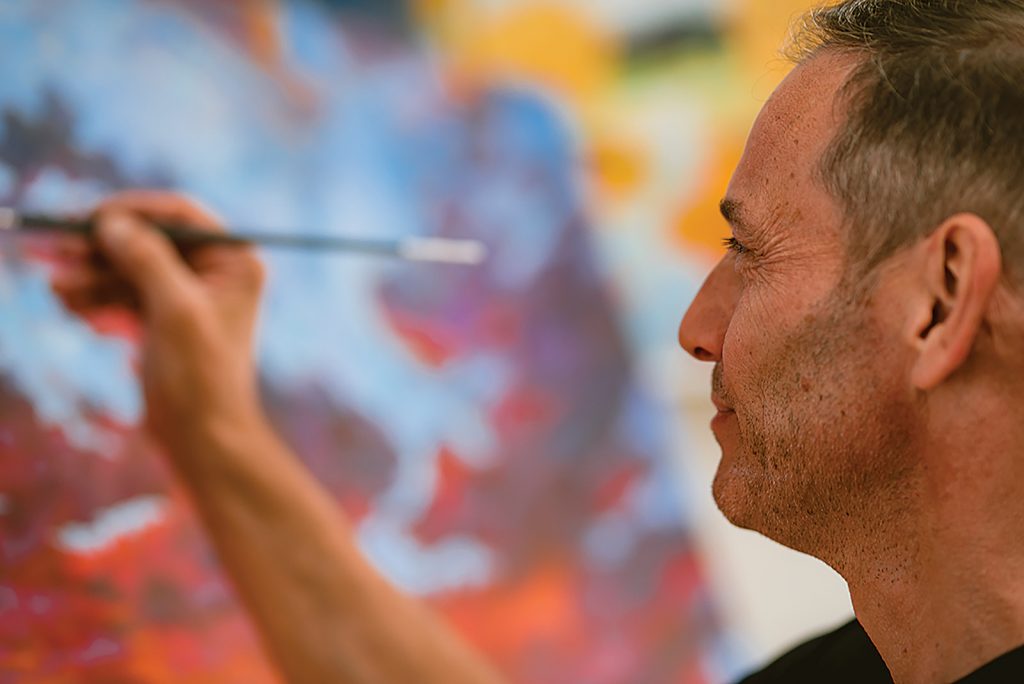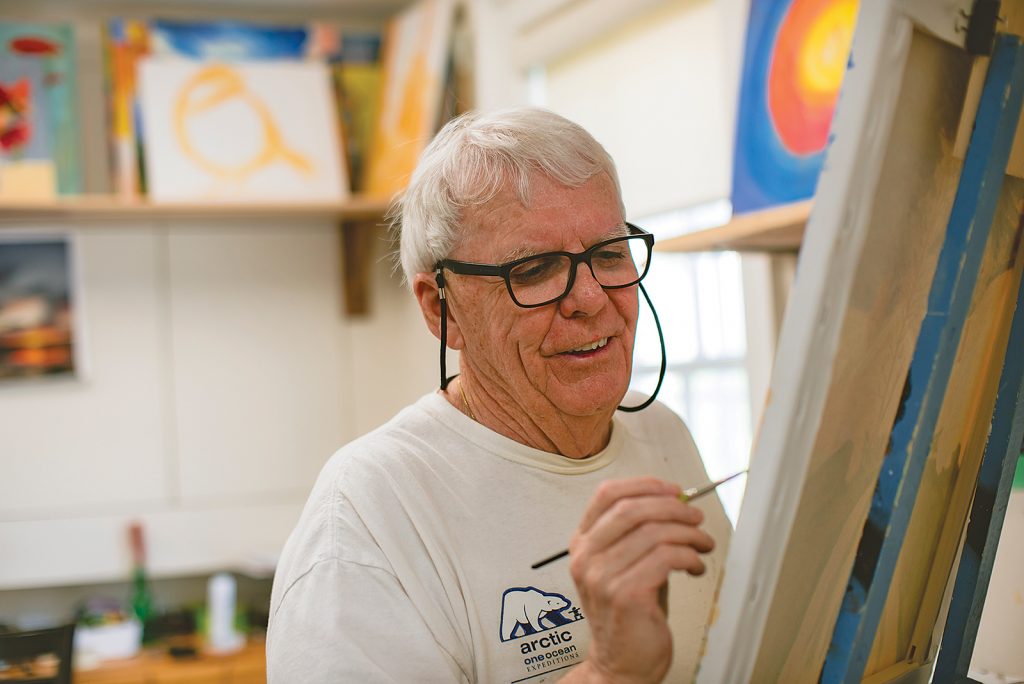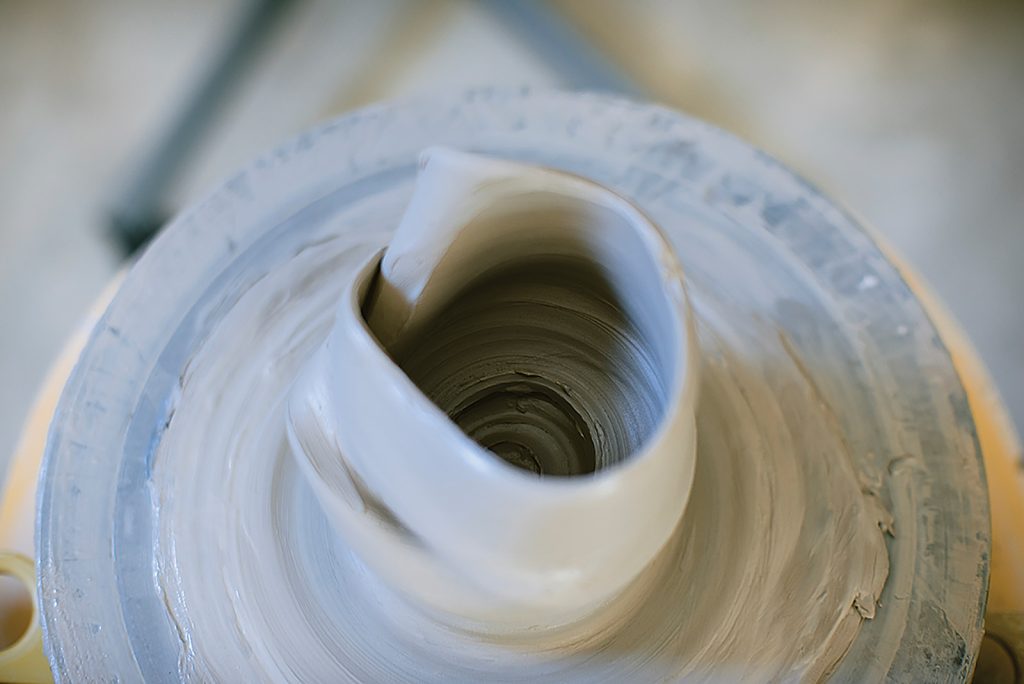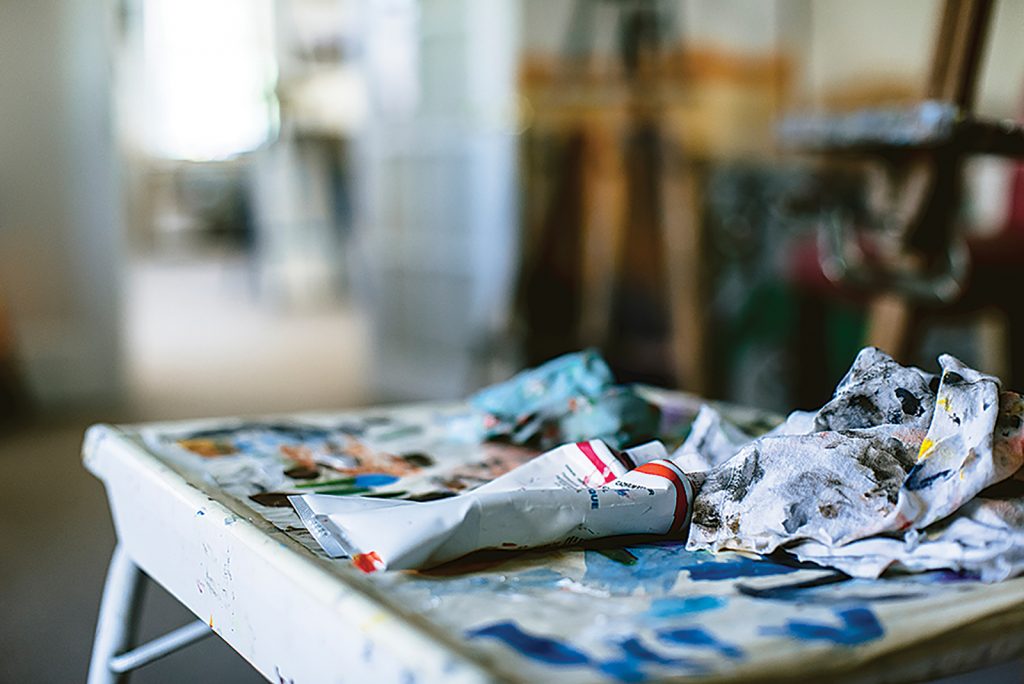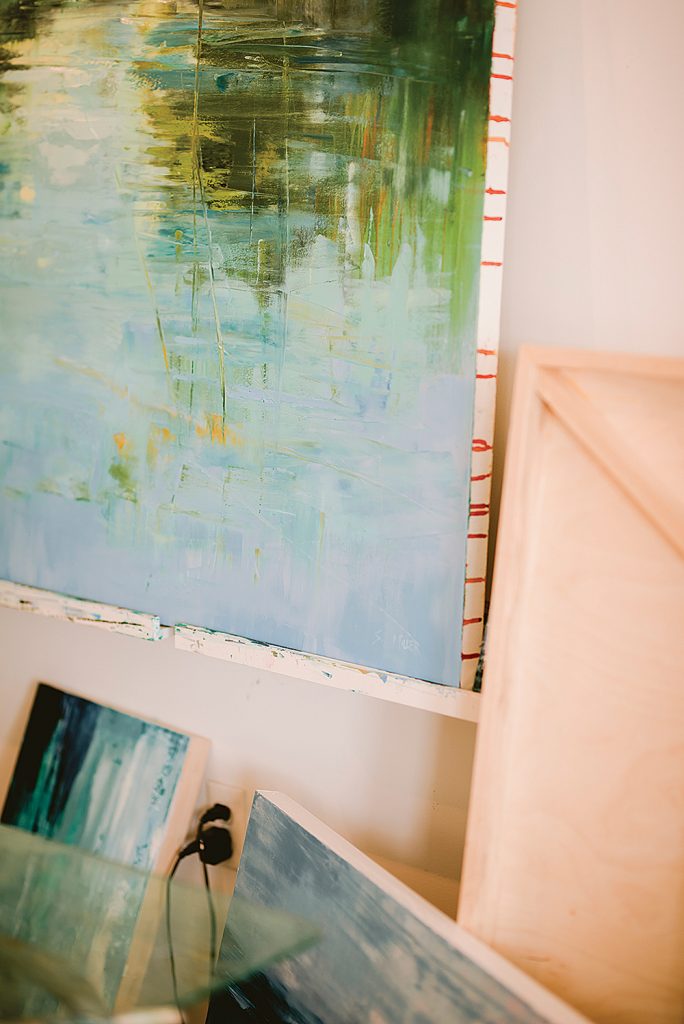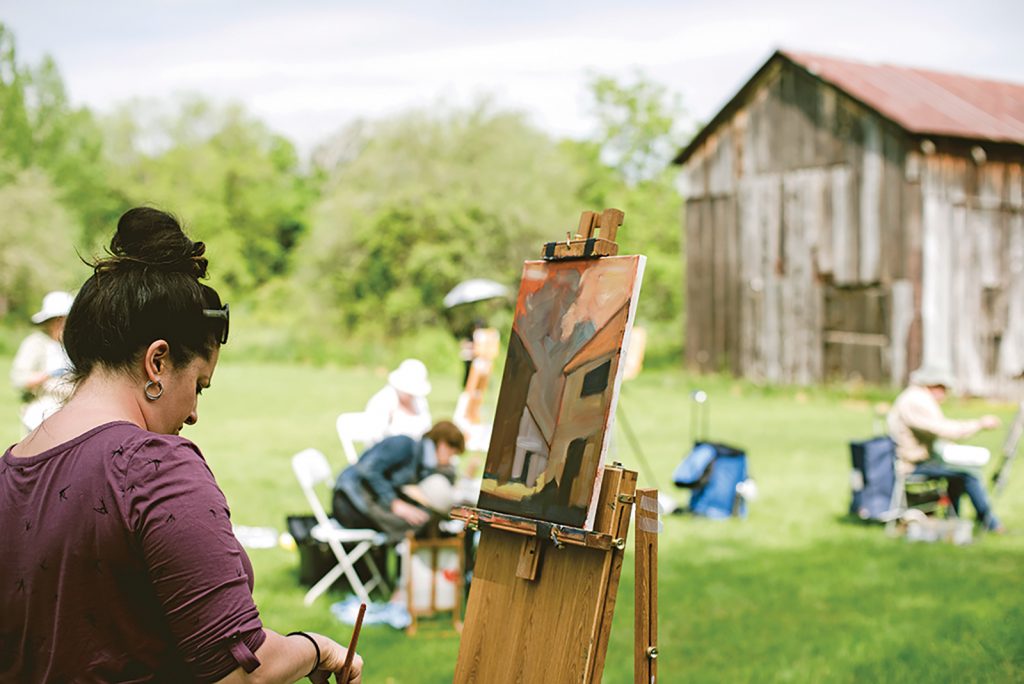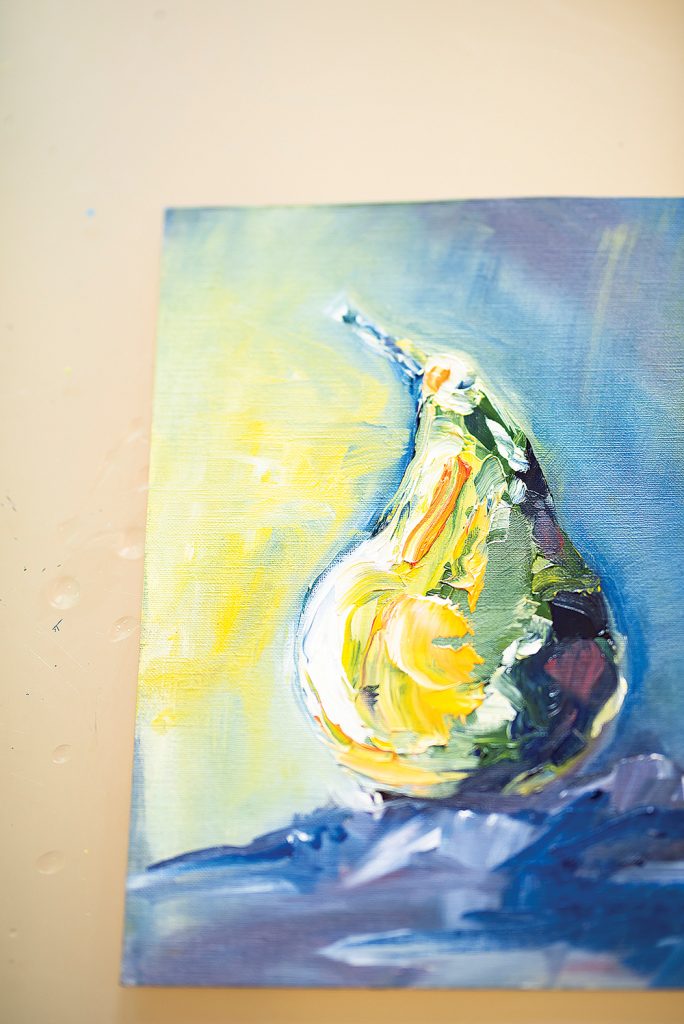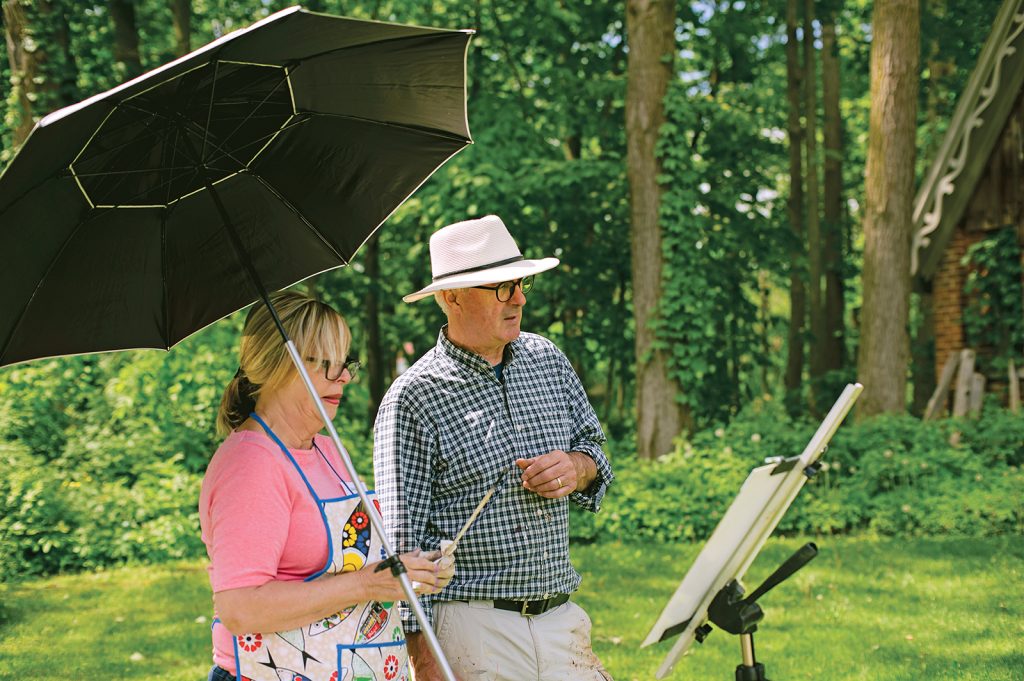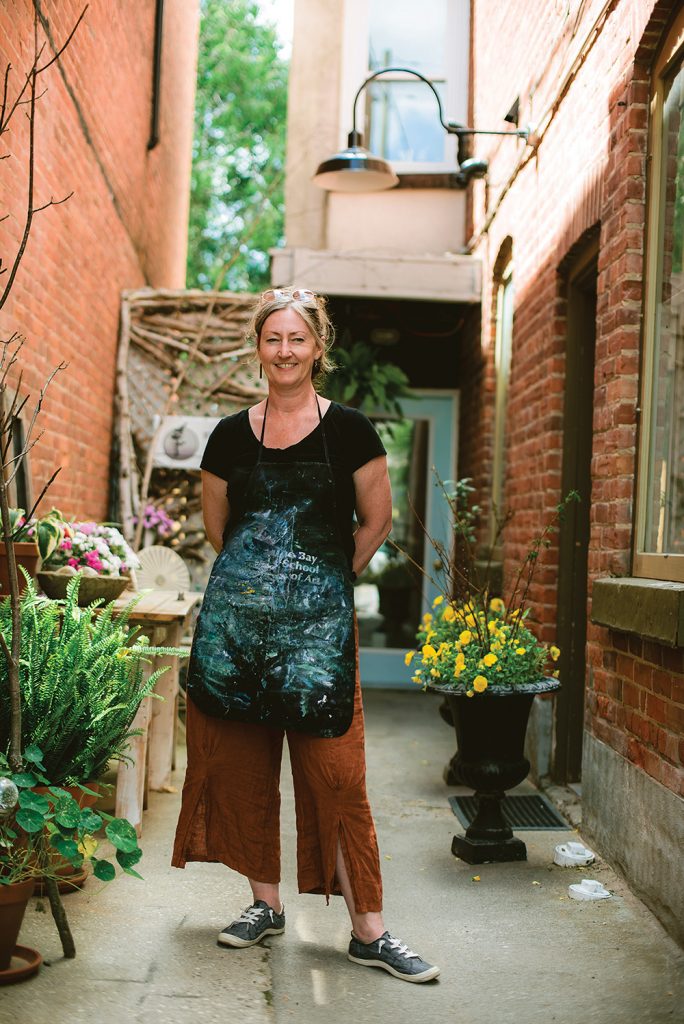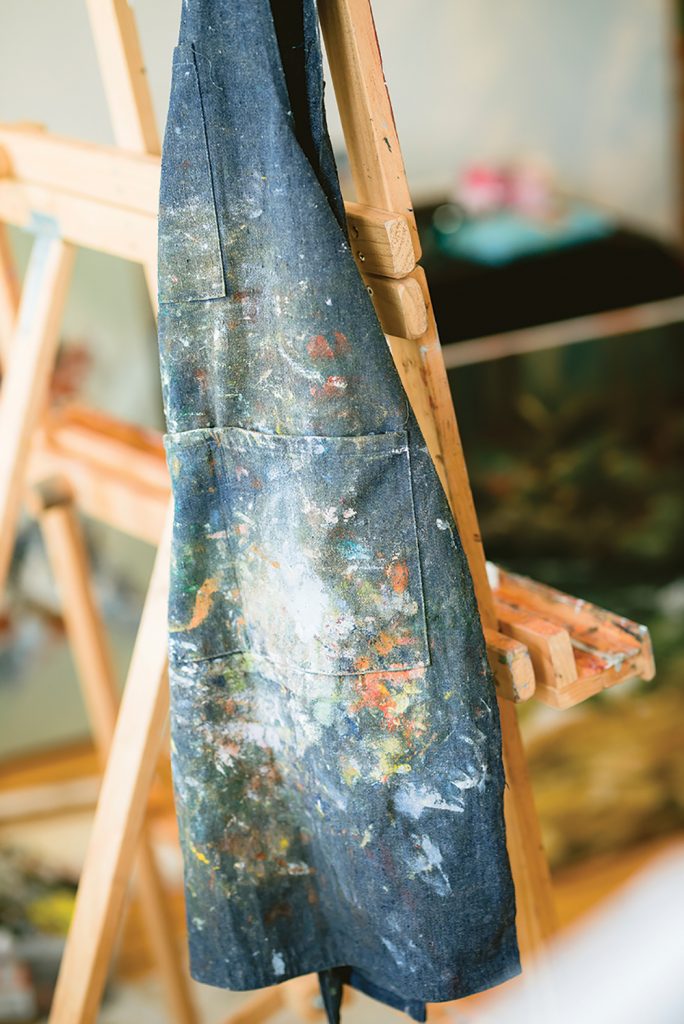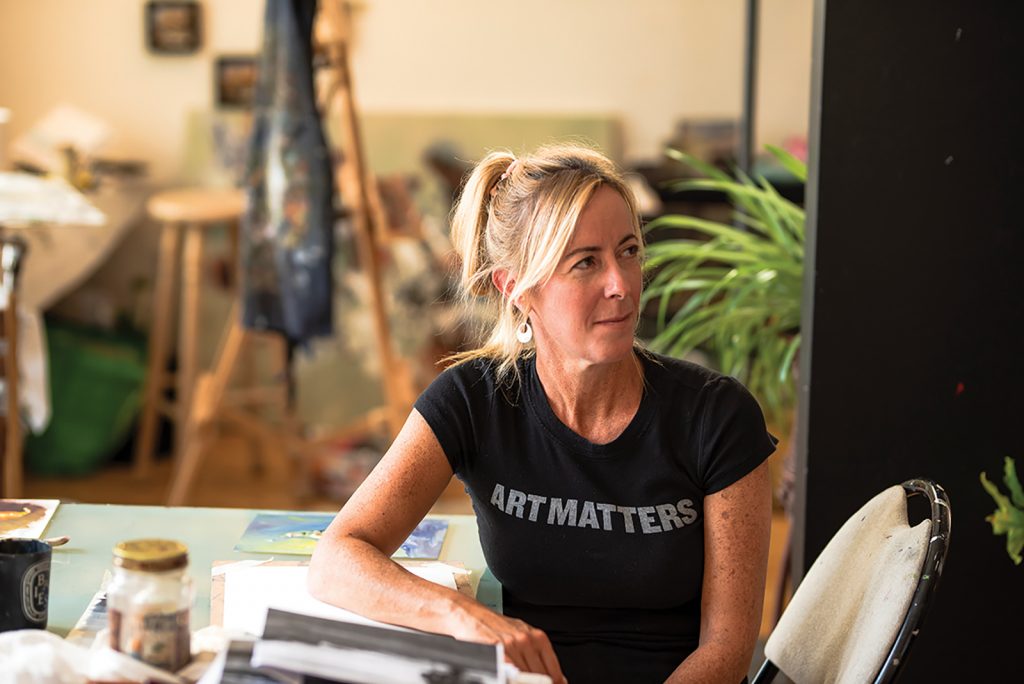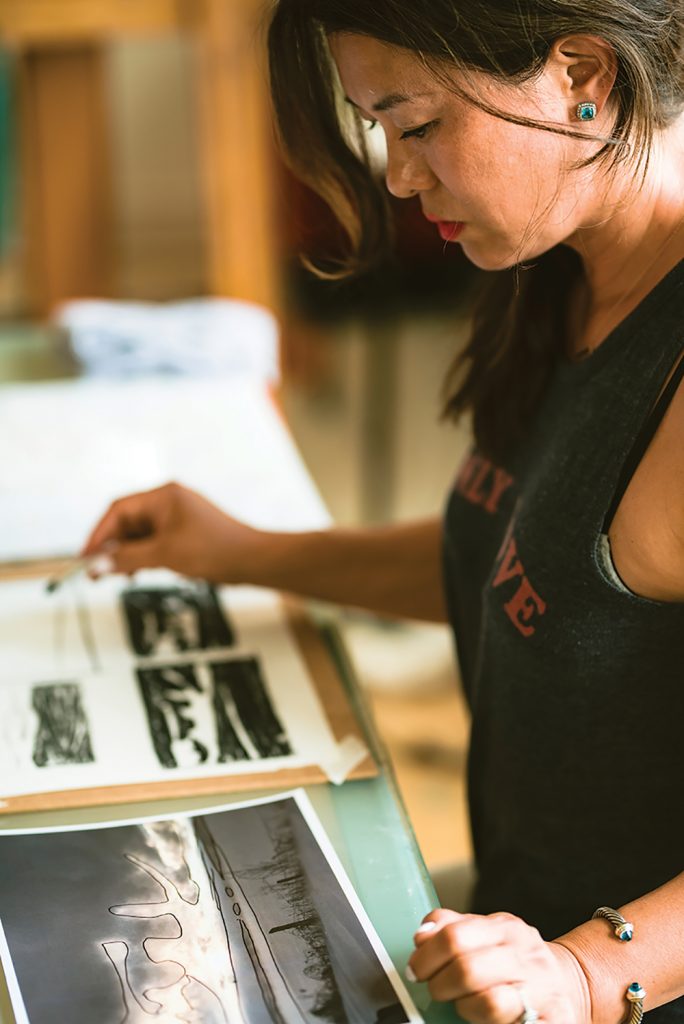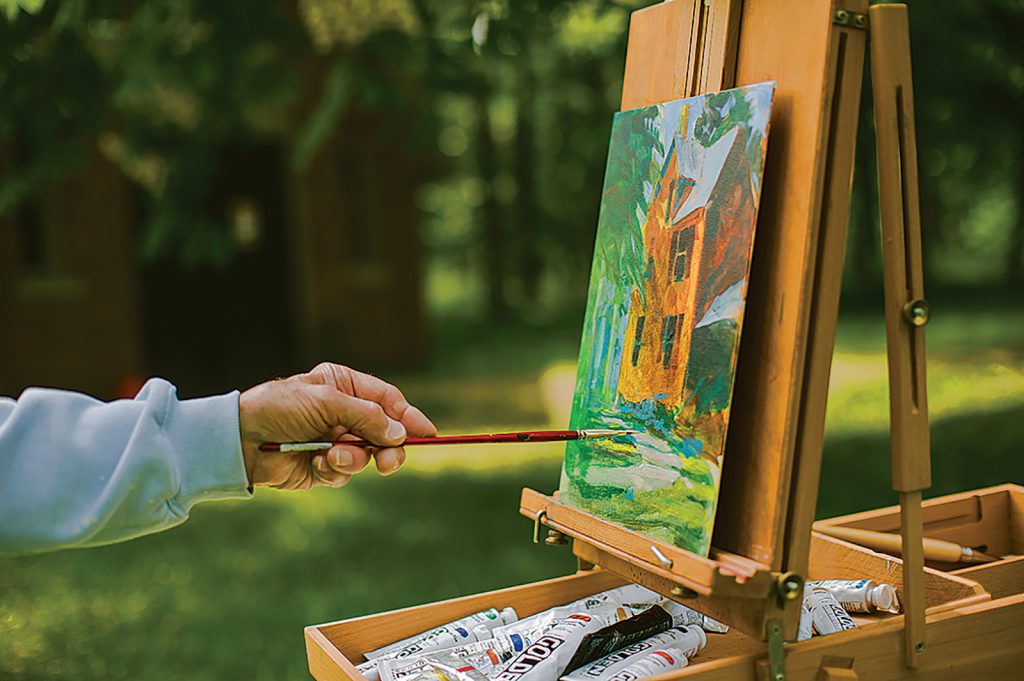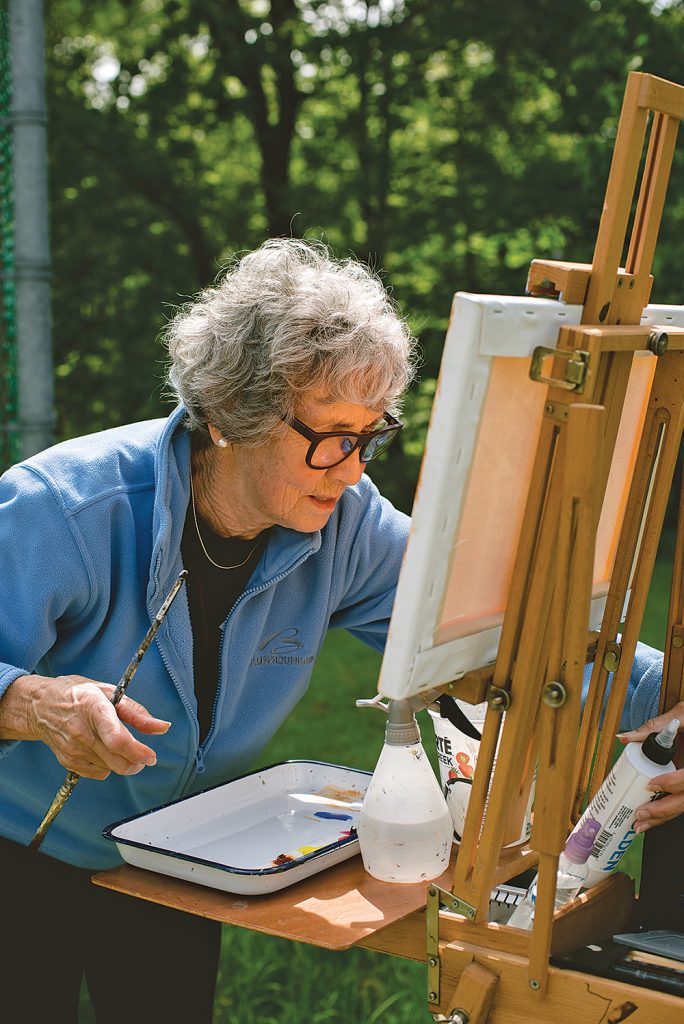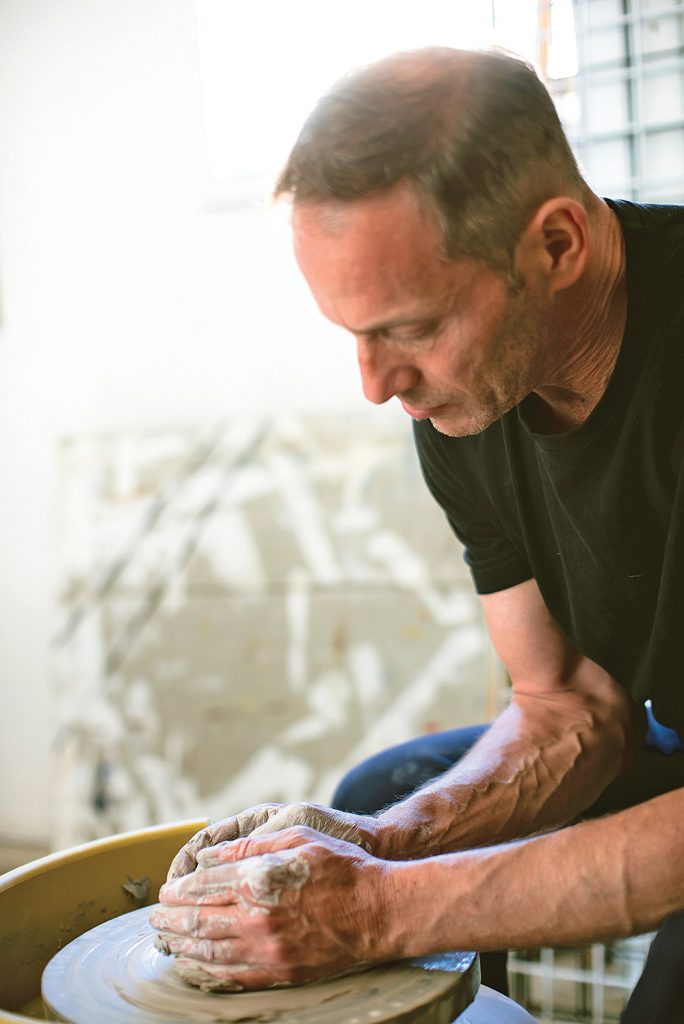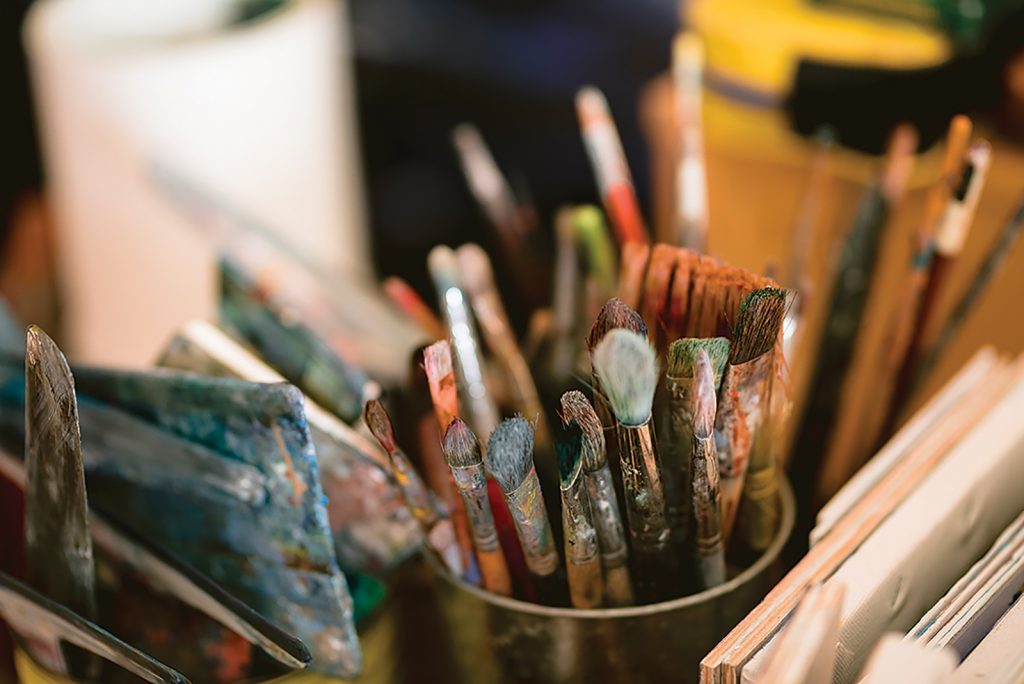Local art classes offer instruction, inspiration and creative expression, from beginner to advanced
by Judy Ross
photos by Jessica Crandlemire
It’s a soft June morning at Swarthmore Farms, a historic property near Meaford where crumbling brick and stone buildings are set amongst ancient trees. For the assembled artists, these abandoned structures are visually exciting. They provide textured subject matter, light and shadow – a rich tableau for painting outdoors, or ‘en plein air,’ with their instructor, the seasoned local artist John David Anderson.
The students, a group of about 20, have arrived with folding chairs, painting equipment, water bottles and snacks, prepared to spend this warm spring day being inspired by the setting and the teacher. Most of them have some painting experience and many have taken these courses for years, enjoying the camaraderie and the encouragement of the group.
The morning begins with a demonstration by instructor Anderson, who works his magic with oil paints. Following this presentation, he waves everyone “off to work,” and the students spread out to choose a spot and set up their easel.
They have enrolled for this five-day course through the Blue Mountain School of Landscape Painting, a not-for-profit organization run by a board of volunteers. Catering to all levels, the school offers courses in May and June, all taught by a roster of accomplished artists. The mission statement of the 40-year-old organization reads: “We exist to provide a venue that enables all those interested in creating art to benefit from working with inspiring instructors in our beautiful landscape.”
Each day involves travelling to a different painting site – lively harbours, pastoral ponds or rivers, and lush private gardens – all selected and set up by the volunteers. The school’s headquarters (and painting studio) in St. Paul’s Presbyterian Church in Thornbury provides a back-up in bad weather.
On this June day, however, the weather is perfect for painting en plein air. The morning begins with a demonstration by instructor Anderson, who works his magic with oil paints. Following this presentation, he waves everyone “off to work,” and the students spread out to choose a spot and set up their easel.
“This is my favourite site,” enthuses Anderson. “It’s dynamite because there is so much to paint here.” Although he has been painting and giving workshops in this area and internationally for years, Anderson is still amazed at his students’ progress. “The learning curve over the five days is quite incredible,” he says. “Sometimes, even though someone has been painting for a long time, they get stuck and just need a kick.”
As far back as the 1920s when the famed Group of Seven brought their sketch pads and painting boxes up to Georgian Bay, artists have been attracted to our region’s dramatic scenes of water, rocks and trees. As a result, the quality of artist/teachers in Southern Georgian Bay is impressive.
Take Jason Alexander, for instance. An Ontario College of Art graduate, he worked in corporate advertising, taught at Centennial College, and has lived, exhibited and sold internationally. In 2008 when he opened his Collingwood art supply store on Hurontario Street, he realized people needed instruction and started giving art classes, which evolved into his school, known today as the Collingwood Art Class.
Alexander’s teaching studios and art supply shop are now situated in a historic building on Simcoe Street, in the heart of the downtown art district. This busy spot is the go-to place for art supplies as well as the venue for a wide array of classes offered both day and night and for all skill levels, mainly on an “open class” basis, which allows students to purchase a five-class pass and then drop in to any class that suits them.
“I paint primarily in acrylic,” offers Kilby, “as do most of my students. But I really try to focus on having a good time. It’s easy to get discouraged when you’re starting out.”
For anyone whose wish list includes playing with clay, Alexander has recently equipped one of his classrooms with pottery wheels and a kiln, and will be offering clay classes in both hand forming and wheel throwing. His three instructors, Steve Martin, Hilary Slater and Deirdre Chase, are all local potters.
Although summer tends to be a quieter time at the Collingwood Art Class, there is still a handful of students at work in Alexander’s studio on one sunny afternoon. They are entirely focused on their easels. Nobody is saying a word; you can literally hear a paintbrush drop. Alexander and his tiny dog, Penny, are quietly circling the room.
“Painting is all about shape and tone,” he says as he suggests a colour change to one of the students. “Everyone here is working on their own reference material: a photo they’ve taken themselves or an image they like. I find if everyone is painting the same thing, in a still life class for instance, it can get competitive and students lose confidence.”
Typically, Alexander’s students are retirees looking for a new activity or realizing a long-held dream. Often, when athletic endeavours get difficult, a more sedentary pursuit like art can be an enjoyable replacement.
Brian Hickey, a Collingwood-based retiree, had to give up golf seven years ago and turned his attention to painting. He now has home studios, both in Collingwood and in his Florida winter home. As well, he takes two, three-hour classes a week with Jason Alexander at the Collingwood Art Class, all for his own enjoyment. “He’s the best teacher I’ve ever had,” says Hickey, standing at his easel painting a scene from a photograph he took in Ireland. “Jason has a way of pointing things out and making subtle changes that make me look good.”
Although learning to paint is in many ways a solitary pursuit, one benefit of taking group classes is the social interaction involved. For Jill Jeffery, a recently retired high school art teacher, the eight-week course she took in abstract painting from Sue Miller at the Mill Street Studio in Creemore allowed her to reconnect with artists in the community. “I had always admired Sue’s work,” she says, “so I wanted to study with her. A bonus was meeting a lovely group of people.”
Miller is now the director of The Bay School of Art, which was started in 2006 by artist and teacher Michelle Fleming. In 2016, Fleming (who continues to paint and teach in Clarksburg) handed over the reins to Miller, who now operates it in Creemore in the Mill Street Art Studio, a charming, bright space on the upper level of a 19th century building. Classes generally consist of groups of seven to 10 students and run for eight to 10 weeks, with separate sessions in the fall, winter and spring.
Apart from becoming absorbed in a new activity and making new friends, painting classes can also offer exciting travel opportunities.
For beginners, Miller recommends “Painting Fundamentals,” an eight-week course she teaches on the basic elements of fine art. “It’s learning the steps involved in building a painting,” she says. “We study colour theory, values (the range from light to dark) and composition, all in a safe, non-judgmental environment.” Sometimes beginners think that taking a course in abstract painting will be easier, but they come away exhausted and discouraged. As Miller explains, “you have to understand the rules before you can break them and make it work.”
In Clarksburg, where artists tend to congregate and galleries line the main street, professional artist and long-time teacher Don Kilby welcomes visitors to his Marsh Street studio, where he offers a variety of classes when he’s not creating his own work. The classes are open-ended, with a maximum of six students who can come and go as they like. Small class instruction is held on Saturday mornings for two hours. Kilby also offers personal one-on-one tutoring and a Thursday night open studio session.
The classes are a combination of demonstrations, work on individual projects, and in-class studies. “I paint primarily in acrylic,” offers Kilby, “as do most of my students. But I really try to focus on having a good time. It’s easy to get discouraged when you’re starting out.”
Kilby advises his students to keep their goals modest. He compares learning to paint with learning to play the piano: “It’s like being new to the piano and wanting to perform Chopin.”
For anyone who wants to try dabbling with paint in a totally non-threatening environment, “paint parties” are the latest craze. You gather a group of friends (up to 10 people) and over the course of an evening you all create your own masterpiece in a party atmosphere. No harsh judgment allowed! All the paints and canvases are supplied, wine and snacks are available, and everyone has a good – and possibly productive – time. Both Don Kilby and Jason Alexander open up their studios for these painting party nights.
If you’ve secretly dreamt of being able to paint but suspect that you have no talent whatsoever, there’s a place for you, too. Art Cunanan teaches, mainly watercolour, in his home-based studio in Collingwood, and is an excellent teacher for beginners. Born in the Philippines, Cunanan studied architecture and fine arts there before coming to Canada 45 years ago. He has inspired thousands of students over his 30 years of teaching. And they in turn spread the word about Cunanan’s talents as a teacher.
“Art Cunanan loves what he’s doing,” says Bonnie Lindsay, who has taken many of his watercolour courses, “and he really tries to make it uncomplicated. Just watching him paint is fun because he starts out with kind of a mess and then in a few minutes he turns the mess into a fabulous painting. He’s like a wizard! And he’s an inspiring teacher.”
Watercolour painting is generally regarded as a more difficult medium, but, as Cunanan explains, it is the most environmentally friendly. Watercolour is safe, easy to carry and simple. It isn’t toxic; it won’t dry out or plug up drains. “Although compared to oil or acrylic,” he concedes, “watercolour is more challenging because you can’t paint on top of it (it gets muddy) and you can’t erase it. It requires patience to learn.”
Most of Cunanan’s students are seniors or retired “and are really just interested in having a hobby,” he notes. But sometimes it goes further and becomes a passion. In his experience, the people who become great painters tend to be passionate and caring; many of his students have gone on to become teachers themselves.
Apart from becoming absorbed in a new activity and making new friends, painting classes can also offer exciting travel opportunities. As an example, for the past 20 years Art Cunanan has been taking a small group of his students on a two-week, all-inclusive painter’s retreat to Limoux, a picturesque French village. And Sue Miller has taken her students to paint in Newfoundland, where she has a cottage.
Back at Swarthmore Farms, it is late afternoon and the day of painting en plein air is coming to an end. Most of the students have completed two paintings and are packing up to leave the serene setting. “It’s really just a beautiful escape,” muses artist Sally Tuck, a long-time board member of the Blue Mountain School of Landscape Painting. “The nice thing about spending a day absorbed in painting is, you lose all sense of time and really don’t think of anything else.”
And really, isn’t that what an appreciation of art can offer us all? ❧







